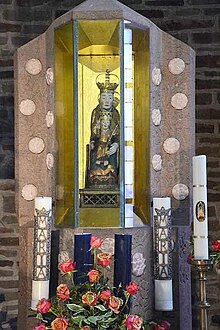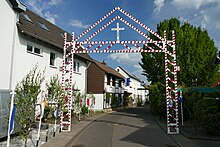St. Katharina (Buschhoven)
The Catholic parish and pilgrimage church of St. Katharina is a listed church building in Buschhoven , a place in the Swisttal community in the Rhein-Sieg district ( North Rhine-Westphalia ). It belongs to the Swisttal pastoral care area in the Meckenheim-Rheinbach dean's office in the Archdiocese of Cologne . Parish patron saint is St. Catherine of Alexandria .
History and architecture
In the pilgrimage church , the miraculous image of the so-called rose Madonna ( Rosa mystica , "mysterious rose", after an invocation in the Lauretanian litany ) is venerated. It is the destination of one of the oldest Marian pilgrimages in the Rhineland. According to tradition, this Madonna was found in 1190 by the knight Wilhelm II von Schilling-Bornheim in the Kottenforst . On this occasion, he donated the Premonstratensian monastery Schillingscapellen , not far from Buschhoven. The monastery, which was taken over by the Augustinian choir women around 1450, fell victim to secularization in 1803 . When the monastery chapel was demolished, the miraculous image was recovered and hidden; on June 22, 1806, it was ceremoniously transferred to the St. Catherine parish church in Buschhoven, which was built in 1723 and is now the Evangelical Reconciliation Church .
The tradition of pilgrimages, which began in Schillingskapellen in 1190/97, was continued here. Since 1972 the Rosa Mystica in Neu- “St. Katharina (Buschhoven) ”. The Maria Stele was created by the sculptor Karl Matthäus Winter .
The following legend has grown up around the Rosa Mystica: It was written in the year 1190: Knight Wilhelm I - called Schilling -, Lord of Bornheim, rode to the hunt. The barking of the dogs lured Schilling to a blooming rose bush. In it he saw the portrait of the Mother of God, standing between two burning candles and next to it a little bell. For knight Wilhelm this was an impetus from God to take the picture with him to Bornheim, where he placed it on the altar of his castle chapel. The next morning the portrait was gone. Ritter Schilling found it at the place of publication. For him it was a sign to build a chapel here - in honor of the Mother of God. The location of the chapel became Schillingskapellen.
On the symbolism: Because of its beauty, its fragrance and its transience, the rose is iconographically in antiquity for beauty and love, but also for the grave and the Elysion . While the first Christians initially had an aversion to roses because of the assignment of flowers to the Roman cult of gods, the church fathers reinterpreted the mysterious flower: the thorns stood for Jesus' crown of thorns , five petals for the five wounds of Christ . The Marian mysticism that emerged in the Middle Ages adopted this symbolism in a similar form. Maria became the Rosa Mystica . Red roses, symbol of martyrdom , stand for the pain of Mary , white roses are a sign of her purity. The forerunners of the church bells are small bells that were used in monasteries to call to prayer until the 14th century. - A candle with a burning wick represents prayer. That is why candles burn in front of images of the Mother of God. The multiple symbols in the Rosa Mystica legend explain the route to the pilgrimage site of Buschhoven (Swisttal).
The new parish and pilgrimage church was built in 1968 under the direction of Werner Fritzen (Bad Godesberg). The east-facing hall church has two bulges in the choir area: left, to the north, for the church tower with the sacrament stele in the sacrament chapel in the basement; right, south and glazed, the baptistery with the baptismal font . The bell tower above the sacrament chapel with the hood-like folding roof is visible from afar above the Swistbachaue . The long walls of the nave have diamond-shaped skylights .
In 1974 the image of grace was transferred to the new church. The previous parish church was acquired by the Evangelical Community. At the annual Maria Rosen Festival on the Sunday before June 24th (Feast of St. John the Baptist ) and in the subsequent octave of pilgrimage , pilgrims from the near and far area still come to Buschhoven.
Every year on the Sunday before the feast of John the Baptist (June 24th) and in the following week the Maria-Rosen-Feast is celebrated with daily church services and processions , to which pilgrims from abroad also come to Buschhoven. To this end, numerous “rose arches” are being erected on the processional routes.
Furnishing
- The miraculous image , a wooden sculpture, probably from the end of the 12th century, is an enthroned Mother of God in archaic forms with a Gothic color setting . The figure stands in a Marian column designed by Karl M. Winter in the church choir. Seven "white" (rose) blossoms made of Estremoz marble are inlaid on both sides of the niche and below . Overall, this Marian stele shows the rose bush ornamentation and thus takes up the theme of the "Rosa mystica".
- Behind the high altar is a wooden triumphal cross group from 1723, which was previously outside the old church .
- The principal pieces were created by the sculptor Karl Matthäus Winter from Limburg): the altar (1970), the sacramental stele (1970/80), the baptismal font (1971) and the ambo (1972) from Portuguese Estremoz marble ; the “housing” for the miraculous image followed in 1975 made of Peperino rosso and Estremoz marble. - Karl M. Winter worked out the altar as a block of Estremos marble with apparently ornamental motifs based on emerging vegetative forms in a symbolic arrangement of numbers - three (trinity, divine), four (concerning the “whole” world) and seven (perfection , Completeness). The “foliage grows together to form a tabletop to serve as a sacrificial altar”, as he himself said in a conversation. The sacrament stele from 1970 contains the same ornamentation as the altar, but here the vegetative forms unite in a common "crown", whereby the number three plays an important role, starting with the hexagonal ground plan (2 by 3). "The ambo from 1972 has many leaves, perhaps because the kingdom of God grows like a stately bush from the little mustard seed of the Annunciation!"
- The stained glass windows with leaded glazing were made in 1970 by Hans Lünenborg (* 1904 in Mönchengladbach; † 1990 in Cologne) in the glass painter's workshop of Dr Reuter & Co in Cologne. The "Rosa Mystica" is thematized in a symbolic and abstract way, only in the entrance wall (west wall) are four lead glass windows with figurative representations in expressive colors ( crucifixion group , St. Catherine, St. Sebastian , Maria in the rose bush).
Peal
The chimes consists of four bells of bronze in the church tower. Two come from the old pilgrimage church, the two larger ones were cast for the new church, one of them (the "rose bell") cast from an older bell that originally came from the Capellen monastery .
| No. | Surname | Strike / nominal |
Diameter (mm) |
Weight (kg) |
Casting year |
Caster |
|---|---|---|---|---|---|---|
| I. | John the Baptist | a ' - 6 | 930 | 500 | 1971 | Hans Georg Hermann Maria Hüesker, Petit & Gebr. Edelbrock , Gescher |
| II | Rosa Mystica (rose bell) |
h ' - 5 | 823 | 350 | 1971 | Hans Georg Hermann Maria Hüesker, Petit & Gebr. Edelbrock, Gescher |
| III | Name of jesus | d " - 5 | 732 | 260 | 1711 | Edmund Fabri, Koblenz |
| IV | Matthias | f sharp " - 5 | 566 | 120 | 1755 | Martinus Legros, Malmedy |
Bell I: JOHANN - BAPTIST - BELL
My name is John the Baptist and I am the voice of the caller
CAST IN 1971 BY THE FA. PETIT U GEBR. EDELBROCK FOR THE NEW CHURCH IN BUSCHHOVEN - TONE A WEIGHT 500 KG -
Bell II: PINK - MYSTICA - BELL
ROSE BELL
At one point I called CAPELLEN
1846 PASTED BY GEORG CLAREN IN SIEGLAR
1971 MOLDED BY THE FA. PETIT AND GEBR. EDELBROCK
FOR THE NEW CHURCH IN BUSCHHOVEN, I AM RING TO HONOR THE ROSA MYSTICA. - TON H WEIGHT 350 KG -
BELL III: NAME - JESUS - BELL
IN HONOREM SS NOMINIS IESV REFVSA SVM SVMPTIBUS RDI ADVM DOMINI
ANTONII VILTZ RECTORIS ET PT CONFESSARII IN SCHILLINGSCAPELL
ANNO 1711
(German: In honor of the most holy name of Jesus I was poured over at the expense of the now most venerable Mr. Antonius Viltz, the rector and current confessor in Schillingskapellen in 1711)
Bell IV: MATTHIAS - BELL
IN HONOREM SANCTI MATTHIÆ APOSTOLI MARTINVS LEGROS ME FECIT ANNO I 7 5 5
(German: Martinus Legros created me in 1755 in honor of the holy apostle Matthias)
- Bells I-III Bell motif: ahddd Gloria
Parish Archives
The parish archives contain a number of valuable archive materials that provide information on village life and political and church events. The inventory includes: Church documents, other official documents, theological books and missals, literature on the Swisttal region and the Rhein-Sieg region, etc. a. School directories, various pictures, sacred objects and various pilgrimage books. Probably the oldest important document dates back to 1197. It is the foundation document for the Schillingskapellen monastery.
literature
- Georg Dehio , edited by Claudia Euskirchen, Olaf Gisbertz , Ulrich Schäfer: Handbuch der deutschen Kunstdenkmäler. North Rhine-Westphalia I Rhineland . Deutscher Kunstverlag , Munich / Berlin 2005 ISBN 3-422-03093-X
- Peter Jurgilewitsch, Wolfgang Pütz-Liebenow: The history of the organ in Bonn and in the Rhein-Sieg district , Bouvier Verlag, Bonn 1990, ISBN 3-416-80606-9 , pp. 496–498. [not yet evaluated for this article]
Web links
- swisttal-buschhoven.de: Adoration of the Virgin Mary
- Heimatfreunde Roisdorf: Report on the pilgrimage
Individual evidence
- ↑ The Church History of Buschhoven / Chronik von Buschhoven, No. 4, edit. v. August Simon, Witterschlick 1980, p. 18.
- ↑ Jürgen Krüger : Rose . In: Walter Kasper (Ed.): Lexicon for Theology and Church . 3. Edition. tape 8 . Herder, Freiburg im Breisgau 1999, Sp. 1300 .
- ^ Gerhard Hoffs and Achim Bursch: Bells in the deanery Meckenheim / Rheinbach. Status of processing: January 28, 2014, pp. 119–125, www.glockenbuecherebk.de (PDF) ( Memento of the original from October 6, 2013 in the Internet Archive ) Info: The archive link was inserted automatically and has not yet been checked. Please check the original and archive link according to the instructions and then remove this notice.
Coordinates: 50 ° 40 ′ 53.7 " N , 6 ° 58 ′ 42.4" E






